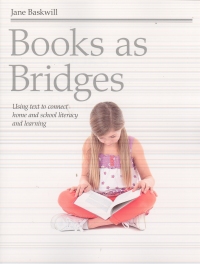| ________________
CM . . .
. Volume XX Number 9. . . .November 1, 2013
excerpt:
Books as Bridges: Using Texts to Connect Home and School Literacy and Learning, by Jane Baskwill, presents teachers with a program to link home and school literacy experiences. Baskwill proposes four guiding principles “that underpin this book and attempt to articulate what we want parents to do to support and nurture children’s literacy learning”: establish reading as a habit, expand general knowledge through nonfiction, see reading as a meaning-making activity, and foster imagination and play (p. 8). Each principle is a chapter in the book, and in each chapter, Baskwill presents a number of strategies to reinforce the principle. For instance, in the chapter “Establishing a Reading Habit”, six types of stories (such as chain or circular stories, pattern stories, cumulative sequence stories) are presented as strategies to foster reading for enjoyment. For each strategy, Baskwill includes four classroom lessons and four home connection letters based on a common children’s book (referred to as a touchstone book). These home connection letters are letters from the teacher to send home to parents and guardians outlining an activity to do with their child at home. The classroom lessons are creative, use a variety of teaching and learning strategies, and include a good selection of children’s literature titles for teachers to choose from. The home literacy connection letters to parents and guardians are clearly explained and reinforce the concepts taught at school. Baskwill also includes a substantial section about how to include parents whose first language is not English into the home/school reading program. However, while the concept of Books as Bridges is a solid one, I have a number of concerns about how this home/school literacy connection is presented and implemented. The first concern I have regarding Books as Bridges is that nowhere is the target age for the student activities in the book clearly stated. Based on the children’s literature and teaching foci in the book, the book best suits the kindergarten to Grade 2 level. The intended grade level should be reflected somehow in the title of the book. It would also be very helpful if there were additional chapters in the book for older students and for teachers of the junior and intermediate grades. Continuing the home/school connection beyond the primary years can be challenging, and there is a missed opportunity here to aid teachers in creating the bridge for these grade levels as well. In addition, the literacy bridge Baskwill proposes is a very one-way bridge. Teachers teach a literacy concept and then send related literacy assignments home for students to do with their families. However, we know from research that, even though families may not engage in traditional school-type literacies at home, students can still have literacy-rich experiences at home. We also know that these different types of literacies and experiences are valuable to students as they learn. The bridge needs to be two-way in that students can bring home literacy into schools. I would love to see a chapter in Books as Bridges that gives teachers ideas on how students can share these homework assignments with their classmates at school. I would also love to see Baskwill make suggestions as to how teachers can also take direction from family literacy to influence the school literacy program. Without this two-way connection, literacy and learning is very top down and school focused. A home/school literacy connection is much more complex than assigning homework based on schoolwork. With modifications, Books as Bridges could serve as a useful starting point for primary teachers looking to start a home/school literacy program. Recommended with reservations. Dr. Kristen Ferguson teaches literacy education at the Schulich School of Education at Nipissing University in North Bay, ON.
To comment
on this title or this review, send mail to cm@umanitoba.ca.
Copyright © the Manitoba Library Association. Reproduction for personal
use is permitted only if this copyright notice is maintained. Any
other reproduction is prohibited without permission.
NEXT REVIEW |
TABLE OF CONTENTS FOR THIS ISSUE
- November 1, 2013.
AUTHORS |
TITLES |
MEDIA REVIEWS |
PROFILES |
BACK ISSUES |
SEARCH |
CMARCHIVE |
HOME |
